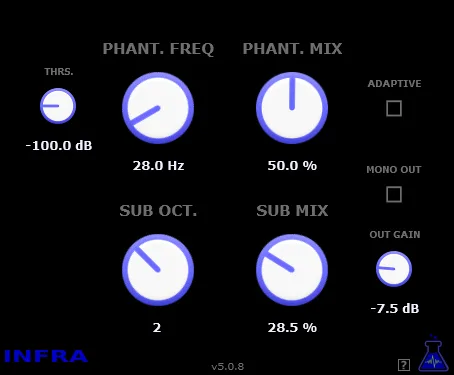Andy Zeugs Anvil: The Foundation of Your Rhythmic Tone
In the world of music production, where every detail matters, creating a solid, punchy, and well-articulated rhythmic foundation is critically important. This is especially true for guitar and bass guitar parts, which often set the overall mood and groove of a composition. This is where the Andy Zeugs Anvil plugin from developer Vadim Taranov comes in – a compact yet powerful tool designed specifically for shaping the perfect “rhythm” sound.
Andy Zeugs Anvil is positioned as a preamp (preamplifier) for the rhythm channel. What does this mean in practice? A preamp is the first stage in the signal processing chain from an instrument. It receives a weak signal, amplifies it to the desired level, and, most importantly, begins to shape its tonal characteristics. The richness, warmth, dynamics, and overall “character” of the sound depend significantly on the preamp, even before it passes through other effects or a cabinet simulator.
The plugin’s focus on the “rhythm channel” speaks to its optimization for parts that require clarity, density, and good intelligibility in the mix. Whether you’re recording powerful guitar riffs for rock or metal, funky “chugs,” or keeping the rhythm on bass guitar, Andy Zeugs Anvil can be that missing link that elevates your sound to a new level.
Key Features and Capabilities
Although information about the plugin is quite concise, the very concept of a rhythm preamp allows for conclusions about its potential capabilities and usage scenarios:
- Initial tone shaping: As a preamp, Anvil serves as the first point for giving the signal the desired richness and harmonics. It can add warmth, slightly compress the signal for a more even dynamic range, or, conversely, add aggression and “cohesion,” which is often needed for punchy riffs.
- Amplification and saturation: The plugin allows you to amplify the signal to a working level while simultaneously adding the saturation characteristic of analog preamps. This can range from a light “coloring” to a pronounced overdrive, depending on the settings (although the specific control knobs are not specified, typical preamps have gain/drive controls).
- Specialization in rhythm: The name “Rhythm Channel Preamp” hints that its algorithms are likely optimized for processing signals with a wide dynamic range, characteristic of rhythmic instruments, while still ensuring good attack and sustain. This may mean special attention to the frequency range, which is important for the intelligibility of the rhythm section in the overall mix.
- Application flexibility: Despite its name, the plugin may be useful not only for guitars or bass. You can try applying it to add character to synthesizers, drums (for example, to enhance the kick or snare drum), or even vocals if you need a certain “dirt” or warmth.
Using it in Your Workflow
Integrating Andy Zeugs Anvil into your Digital Audio Workstation (DAW) is standard for VST plugins. Since it is available in VST format for Windows (Win32), users of the corresponding operating systems and hosts can easily add it to their arsenal.
A typical usage scenario will involve placing Anvil first in the effects chain for guitar or bass, before the amplifier and cabinet simulator (if you use them) or other modulation or time-based effects. It will act as the “front end” of your virtual amplifier, giving the signal its initial shape and saturation.
Experiment with the input signal level and the internal parameters of the plugin (if available) to find the perfect balance between clarity, warmth, and drive that best suits your rhythmic track. Remember that even small changes at the preamp stage can significantly affect the final sound after passing through other effects.
The Andy Zeugs Anvil plugin is an interesting offering for musicians and sound engineers looking for a simple yet effective way to give their rhythmic instruments a professional sound. Its specialization in the rhythm channel makes it a valuable tool for achieving a tight and punchy mix, which is the foundation of any successful composition. Try Anvil in your projects to feel how a correctly shaped initial tone can change your perception of rhythm.
Created by Vadim Taranov, this plugin is an example of how targeted tools can solve specific sound engineering tasks, helping to achieve the desired result faster and more efficiently. If you’re working with guitar or bass guitar parts and looking for a way to improve their place in the mix, Andy Zeugs Anvil deserves your attention.



